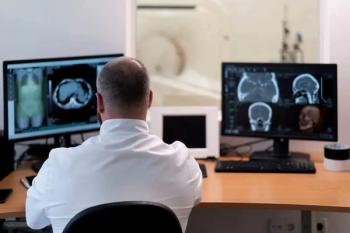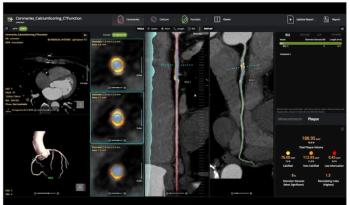
ATL launches real-time perfusion echocardiography software
Technology makes use of ultrasound contrast agents Ultrasound developers have long sought to broaden the reach of the modality to support myocardial perfusion imaging. But sonography has not yet been able to compete with nuclear medicine and
Technology makes use of ultrasound contrast agents
Ultrasound developers have long sought to broaden the reach of the modality to support myocardial perfusion imaging. But sonography has not yet been able to compete with nuclear medicine and cardiac catheterization.
ATL Ultrasound hopes to change that situation. The Bothell, WA-based company this month launched a new technology, Real-Time Perfusion Imaging, which, when used with contrast agents, will help clinicians evaluate cardiac small vessel circulation. Real-Time Perfusion Imaging could allow physicians to conduct contrast echocardiography exams more quickly and easily, imaging blood circulation in the myocardium for at-risk patients before the infarction happens, rather than after it has occurred, according to ATL.
Introduced at this months American Heart Association meeting in Atlanta, Real-Time Perfusion Imaging is part of ATLs Performance 2000 upgrade package for its HDI 5000CV ultrasound scanner. The software is based on ATLs pulse inversion technology, Power Pulse Inversion, a postprocessing capability that cancels out the fundamental transmit and receive signal, leaving just the harmonic waveform returned by the contrast agent. In the resulting image, contrast agent signal is seen in color, while tissue is displayed in gray scale. This differentiation enables sonographers to see small amounts of contrast. As a result, Power Pulse Inversion technology makes the use of ultrasound contrast more effective, according to the company.
To date, contrast-enhanced echocardiography has been used only in limited applications, such as imaging endocardial borders. But in ATLs clinical trials, researchers found that Real-Time Perfusion Imaging allows for visualization of cardiac wall motion and small vessel circulation in real-time.
In addition, ATL executives believe the technology has potential to eliminate the need for intermittent acquisition methods such as ECG gating to capture ultrasound images of the heart. ECG gating requires the use of high acoustic output power, which destroys the contrast agents microbubbles and prevents clinicians from imaging myocardial perfusion. Real-Time Perfusion Imaging uses lower acoustic output, thus protecting the bubbles and producing a higher resolution image, as well as extending the life of the contrast agent, ATL said.
Although it is commercially available, Real-Time Perfusion Imaging technology is dependent on contrast agents that have not yet been cleared by the Food and Drug Administration for this purpose, according to Jim Brown, senior director of clinical/technical marketing.
We cant claim (that Real-Time Perfusion Imaging technology) can perform myocardial perfusion imaging, because agents arent yet approved for that use, Brown said. But we can claim that it improves small vessel imaging. Were working with contrast manufacturers, many of which are using our equipment and are starting their own trials using this real-time perfusion imaging method.
A handful of companies have agents either available or close to market clearance for some ultrasound echocardiography applications. None have clearance for use for myocardial perfusion, however. Molecular Biosystems and its marketing partner, Mallinckrodt, won clearance in January 1998 for Optison, and the two firms have continued to conduct clinical trials for other applications, including cardiac perfusion (SCAN 1/14/98).
Sonus Pharmaceuticals is awaiting FDA clearance for its agent, EchoGen (SCAN 10/13/99), and research continues into further clinical utility of the agent, including the potential for myocardial perfusion. In addition, Sonus is developing a next-generation agent, called SonoGen, primarily for use in myocardial perfusion studies. Phase I trials of the agent, also called QW7437, have been completed.
In December 1998, Du Pont Pharmaceuticals submitted a new drug application to the FDA for Definity, an echocardiography and abdominal imaging agent developed in collaboration with ImaRx Pharmaceuticals (SCAN 12/16/98). Du Pont strengthened its commitment to Definity in October by acquiring ImaRx, and with the acquisition gained not only the product, but worldwide marketing rights and its patent estate (SCAN 10/27/99).
Real-Time Perfusion Imaging is only one of ATLs recent offerings intended to expand the parameters of ultrasound use. In September, the company introduced another Performance 2000 option, SonoCT Real-Time Compound Imaging, software that creates tomographic ultrasound images by sampling tissue from nine viewing angles, and cleans up the artifacts that compromise ultrasounds image quality (SCAN 9/29/99). The technology produces nine times more information about the tissue than the data produced by conventional imaging, according to the company.
Like SonoCT, Real-Time Perfusion Imaging has the potential to deliver much more information about the heart than traditional imaging methods, according to Brown.
The whole goal is to be able to detect the events when theyre happening, to look at infarction before it causes damage, he said. Real-Time Perfusion Imaging allows ultrasound to be a cost-effective method for detection and follow-up. In the area of heart and coronary artery disease and patient management, ultrasound has been relegated to use after the fact. But now we have the capability to deal in real-time.
Newsletter
Stay at the forefront of radiology with the Diagnostic Imaging newsletter, delivering the latest news, clinical insights, and imaging advancements for today’s radiologists.





























